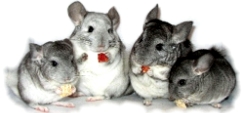
Standard gray is the original color of all chinchillas.
Mutations [beige, white, black, ebony, violet and sapphire and the different variations of each] came about by doing selective breeding and inbreeding over many generations.
The visual appearance of each lets you know allot of what is in the background of each one ... but a chinchilla can "carry" other mutation genes
that are not visible in the appearance of the chinchilla ...
these are "hidden" genes that
can show up in later generations.
Example: If you have what is commonly known as a "pink white" which is technically a white/beige cross ...
If you breed it to a standard, you could have kits that were standards, pink whites and/or beige.
All three kits
get their genes from both parents, eventhough they may not "show" or have the same appearance.
By just looking at the pink white kit is obviously carrying the genes of the pink white parent.
The beige is obviously carrying the genes of the pink white parent, because a pink white carries both the white and beige genes.
You can tell this just by looking at the kits and the parents.
In this example the standard gray colored kit also carries genes from both parents {the pink white and the standard} To look at it ... it just looks like a regular/plain/pure standard ... BUT ... because it is carrying the pink white genes of the other parent, it is not a pure standard gray. It is a standard gray/white carrier.
What's the use of showing what genes are carried but not visible ...
because it can show up in a future generation. If you put two standard gray/white carriers togeher ... the odds are they will have mostly standard gray kits ... but, there is also a "chance" of both parents (if they are both carrying the white gene) to "throw" it to one or more kits {rare} and produce a pink white or a beige kit.
This is why it is always good to make sure you know the colors of the parents and grand parents ... even futher back, if possible. Sometimes a mutation color will not show back up for several generations. The ebony is often called a "wild card" because it is notorious for showing back up when least expected as a chin with a "dirty belly" or a wrap veration of that color (such as a tan or a violet wrap).
Hope this helps and does not confuse you even more. Genetics is just not that easy to explain.


Jo Ann
Alice Kline, author of "After 40 Years ...", also, wrote/composed a great book on Chinchilla Mutations. There is a website called Silverfalls Chinchillas that will help you to determine the odds/percentage for what two chinchillas will produce if you put them into breeding together ... but ... if you do not know what all each chin carries (genes that are not visible), it is not as accurate ... it can't be without all the information.

 Author
Topic: Eyes... (Read 7721 times)
Author
Topic: Eyes... (Read 7721 times)




